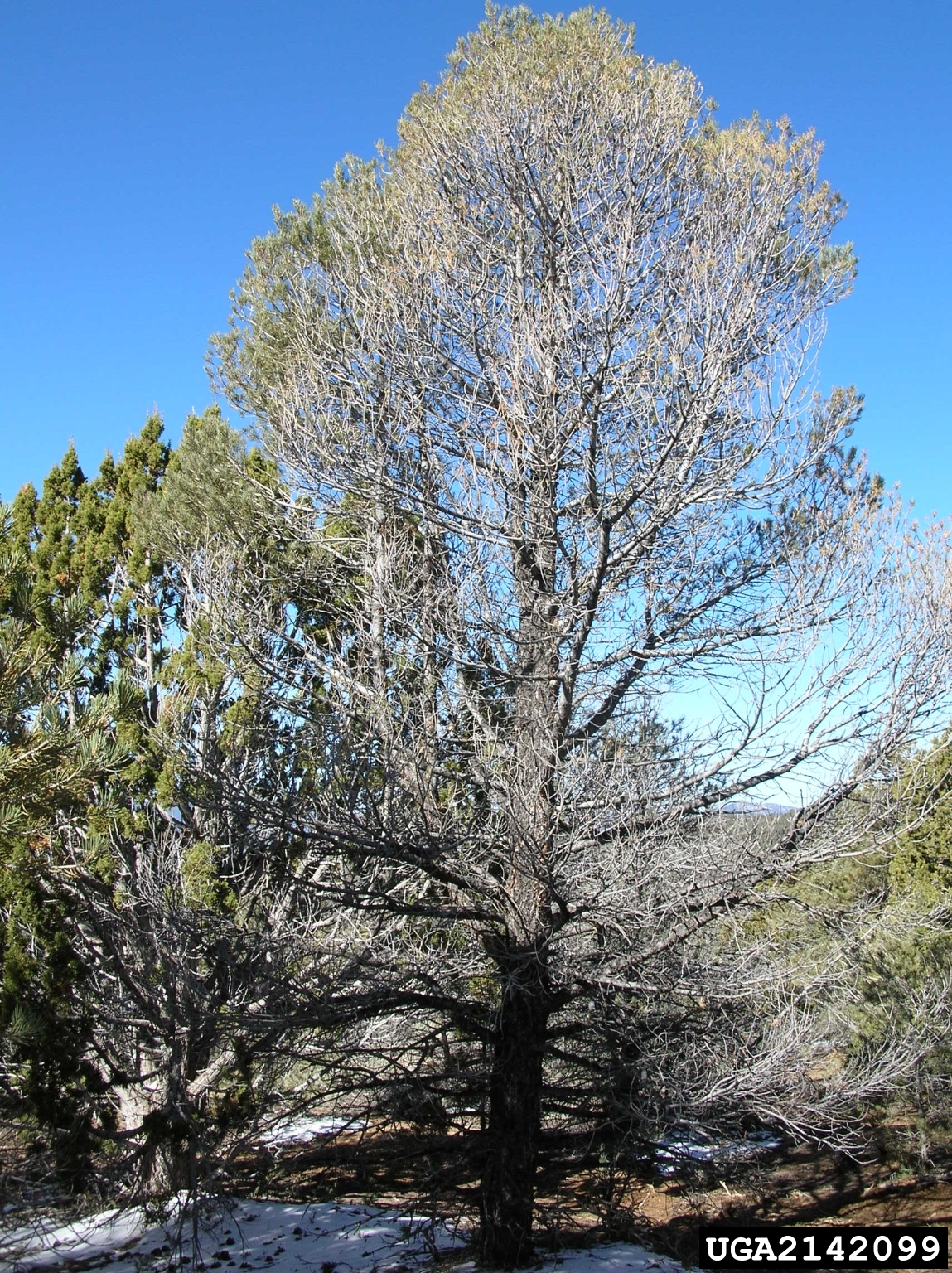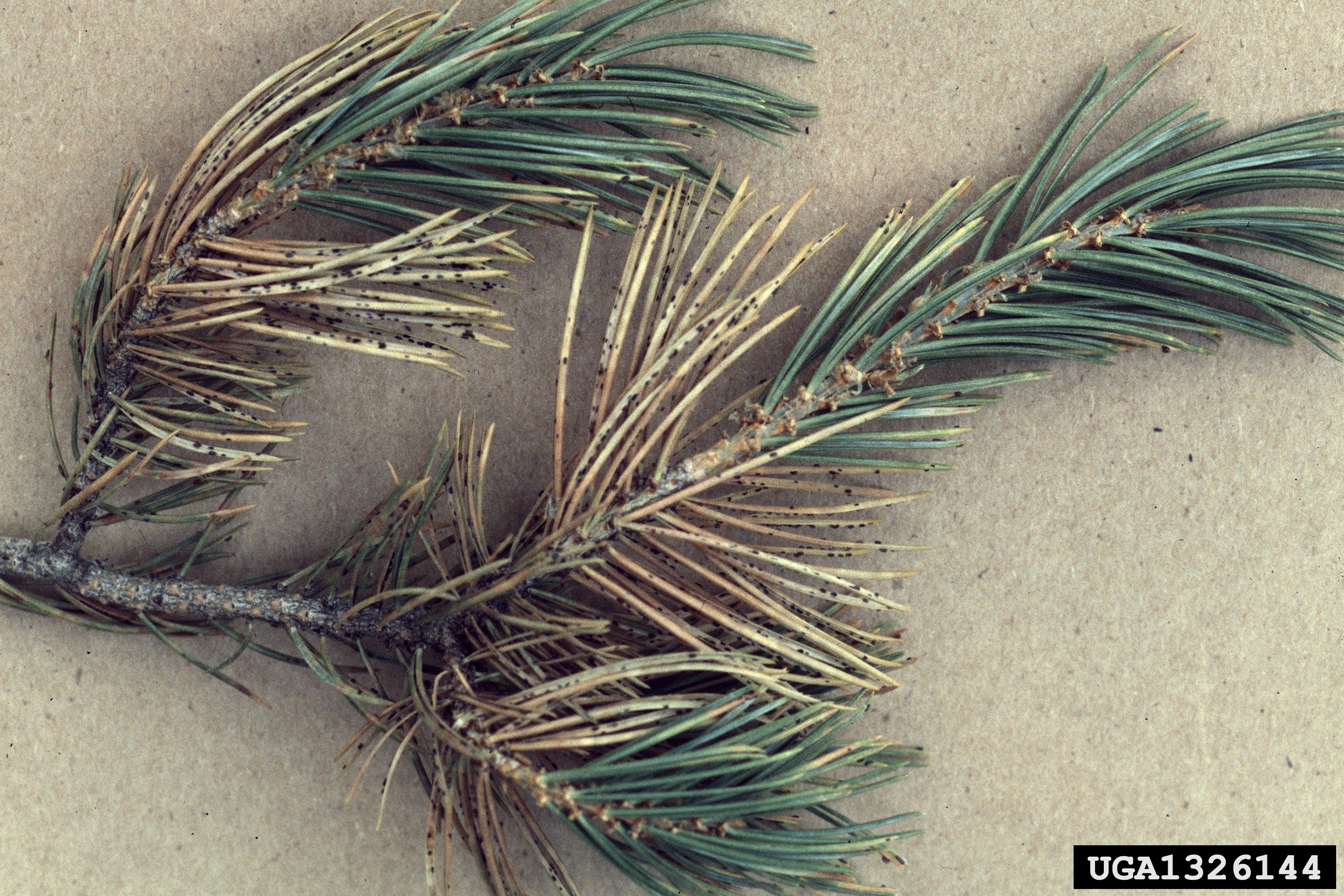 Pinyon Needle Scale - March 24, 2021 Jeff Schalau, Agent, Agriculture & Natural Resources University of Arizona Cooperative Extension, Yavapai County In recent years, Sedona and Prescott area pinyon pines have experienced an increase in colonization by pinyon needle scale (Matsucoccus acalyptus). This native insect has a complex life cycle and can cause slow decline and eventual death of native-grown and planted pinyon pines. It can be managed, but this can be labor intensive and often requires strategic applications of insecticides. Like any potentially destructive insect, one must understand its life cycle before effective management actions can be taken. Pinyon needle scale (PNS) lowers an individual tree’s vigor by repeatedly colonizing the leaves (needles) formed during the previous year’s growing season. A pinyon pine not colonized by PNS will maintain four or five years of needle growth before dropping shedding the older needles. Over successive years of colonization by PNS, the tree only has the previous years’ needles and cannot store enough energy through photosynthesis to meet its needs and maintain defenses against other pests. The canopy of an infected tree often declines over several years before it succumbs. Immature male PNS emerge from the scale covering in late fall and pupate in the soil below the tree. In early spring, the wingless, mature female PNS emerges from its scale covering. Simultaneously, the mature, winged adult males emerge from the soil to mate with females. This emergence is temperature dependent and often occurs in late February and early March. After mating, the females lay yellow eggs in clusters of white, cottony webbing at the base of the tree, on undersides of large branches, in branch crotches, or in cracks of rough bark. Eggs may also be found on rooftops and rain gutters of buildings adjacent to colonized pinyons. These eggs hatch into crawlers that move up the tree to the branch tips. The crawlers colonize the previous year’s foliage causing severe needle stunting and defoliation. They may also colonize new foliage during heavy infestations. They feed on the cell sap of foliage using piercing mouthparts. Once feeding begins, they become immobile, cover their body with a waxy coating, and turn black. In central and northern Arizona, this normally occurs in late May or early June, but this may occur earlier this year. They remain attached to the needle for the growing season maturing inside their protective shell. In spring, they resume growth until they emerge as adults to mate and create a new generation the following year. Sanitation methods can greatly reduce population levels and minimize or eliminate the need to apply insecticides. This requires the homeowner to monitor egg-laying activity and destroy the egg masses before they hatch. Rake up the egg masses, bag, seal, and discard them with household waste. Then, wash the remaining egg masses away from the tree with a high-pressure hose. For planted pinyons, deep, infrequent irrigation can also maintain individual tree vigor when combined with sanitation practices described above. The adult’s waxy, protective coating safeguards them from environmental factors, predators, and contact insecticides. However, chemical control can be effective if applied at the proper life stage. Contact insecticides, such as Malathion and horticultural oil, are effective when scales are in the crawler stage. This requires close monitoring and multiple applications to effectively reduce populations. Dimethoate is a systemic insecticide labeled for application on pinyon needle scale egg masses prior to emergence. There have also been some homeowners in the Prescott area applying imidicloprid-containing insecticides (Merit, Winner, and others) using a root drench. This assumes you can apply the materials in the location that tree roots are able to take up the active ingredient and translocate it to the leaves. The homeowners report moderate success, but this treatment can be very expensive if multiple trees are treated. Most homeowners use the sanitation practices described above. It is labor-intensive but largely effective. Others contract with commercial pesticide applicators for treatments. Here, application timing, application method, and effective material must all be correctly orchestrated to be effective. Also, if considering imidicloprid, remember this is the material that is toxic to bees and other pollinators. I have included photos and additional resources below. Naming of companies or products is neither meant to imply endorsement by the author nor criticism of similar companies or products not mentioned. You can follow the Backyard Gardener on Twitter – use the link on the BYG website. If you have other gardening questions, email the Master Gardener Help Desk in Prescott (prescottmg@gmail.com) or Camp Verde (verdevalleymg@gmail.com) and be sure to include your name, location, and phone number. Find past Backyard Gardener columns or provide feedback at the Backyard Gardener web site: https://cals.arizona.edu/yavapai/anr/hort/byg/. Images  Pinyon pine defoliated by pinyon needle scale (Matsucoccus acalyptus, Brytten Steed, USDA Forest Service, Bugwood.org).  Pinyon needle scale (Matsucoccus acalyptus) on foliage (Whitney Cranshaw, Colorado State University, Bugwood.org).  Pinyon needle scale (Matsucoccus acalyptus) egg masses on tree trunk (Whitney Cranshaw, Colorado State University, Bugwood.org).  Pinyon needle scale (Matsucoccus acalyptus) egg masses on tree trunk (Whitney Cranshaw, Colorado State University, Bugwood.org). Additional Resources Pinyon Needle Scale, USDA Forest Service cals.arizona.edu/extension/ornamentalhort/plantprotect/pinyonscale.pdf Pinyon Needle Scale, New Mexico State University Extension aces.nmsu.edu/ces/yard/2004/013104.html Pinyon Needle Scale, USDA Forest Service Forest Health Protection, Rocky Mountain Region www.fs.usda.gov/Internet/FSE_DOCUMENTS/stelprdb5343828.pdf |